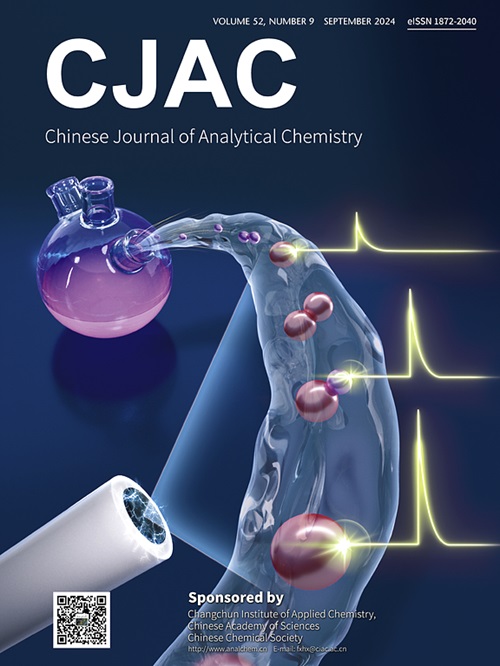Qiyu Granules ameliorate insulin resistance via modulating PI3K/AKT/FoxO1 pathway and AMPK/PPARγ pathway in diabetic KKAy mice
IF 1.3
4区 化学
Q4 CHEMISTRY, ANALYTICAL
引用次数: 0
Abstract
Objective
To investigate the protective effect and mechanism of Qiyu Granules in alleviating insulin resistance in KKAy mice.
Methods
The chemical ingredients of Qiyu Granules were analyzed using ultra performance liquid chromatography-quadrupole time-of-flight mass spectrometry (UPLC-Q-TOF-MS). Network pharmacology and animal experiments were used to verify the pharmacological effects of Qiyu Granules in alleviating insulin resistance in diabetic KKAy mice and to explore its mechanism of action. High-sugar, high-fat chow was fed to KKAy mice for modeling. After 12 weeks, indicators of glucose metabolism (FBG, AUC), lipid metabolism (TC, TG, LDL, HDL, FFA), liver function (ALT, AST) and insulin resistance (FINS, HOMA-IR, HOMA-β, ISI) were detected. Pathological changes in pancreatic and liver tissues were observed by hematoxylin-eosin (H&E) and Oil Red O staining. Hepatic glycogen levels were analyzed using enzyme-linked immunosorbent assay (ELISA) method and periodic acid-Schiff (PAS) staining. Western blot was used to detect the protein expression levels of InsR, p-PI3 K, p-AKT, FoxO1, PEPCK, G6pase, p-AMPK, p-GSK-3β, GLUT2, PPARγ and PPARα.
Results
FBG, AUC, HOMA-IR, TC, TG, LDL, FFA, ALT, AST and hepatic index were decreased in mice treated with Qiyu Granules; while FINS, HOMA-β, ISI, HDL and hepatic glycogen content were increased. Qiyu Granules also improved histopathological changes in the pancreas and liver of KKAy mice. Besides, Qiyu Granules up-regulated the expression levels of InsR, p-PI3 K, p-AKT, p-AMPK, GLUT2 and PPARα proteins in the livers of mice in the model group. However, Qiyu Granules down-regulated the expression levels of FoxO1, PEPCK, G6Pase, p-GSK-3β and PPARγ proteins.
Conclusion
Qiyu Granules may regulate the InsR/PI3K/AKT/FoxO1 pathway, AMPK pathway, and PPARγ/PPARα pathway to ameliorate insulin resistance. Therefore, Qiyu Granules is a promising hypoglycaemic agent for the treatment of DM.

芪郁颗粒通过调节糖尿病KKAy小鼠的PI3K/AKT/ fox01通路和AMPK/PPARγ通路改善胰岛素抵抗
目的探讨芪郁颗粒对KKAy小鼠胰岛素抵抗的保护作用及其机制。方法采用超高效液相色谱-四极杆飞行时间质谱法(UPLC-Q-TOF-MS)对七羽颗粒的化学成分进行分析。通过网络药理学和动物实验验证芪郁颗粒减轻糖尿病KKAy小鼠胰岛素抵抗的药理作用,并探讨其作用机制。给KKAy小鼠喂食高糖、高脂肪的食物进行建模。12周后,检测各组糖代谢指标(FBG、AUC)、脂代谢指标(TC、TG、LDL、HDL、FFA)、肝功能指标(ALT、AST)和胰岛素抵抗指标(FINS、HOMA- ir、HOMA-β、ISI)。苏木精-伊红(H&;E)和油红O染色观察胰腺和肝脏组织的病理变化。采用酶联免疫吸附法(ELISA)和周期性酸-希夫(PAS)染色法分析肝糖原水平。Western blot检测InsR、p- pi3k、p-AKT、fox01、PEPCK、G6pase、p-AMPK、p-GSK-3β、GLUT2、PPARγ、PPARα蛋白表达水平。结果芪郁颗粒可降低小鼠fbg、AUC、HOMA-IR、TC、TG、LDL、FFA、ALT、AST及肝脏指数;FINS、HOMA-β、ISI、HDL、肝糖原含量升高。芪郁颗粒还能改善KKAy小鼠胰腺和肝脏的组织病理学改变。芪郁颗粒上调模型组小鼠肝脏中InsR、p- pi3k、p-AKT、p-AMPK、GLUT2、PPARα蛋白的表达水平。而芪郁颗粒可下调fox01、PEPCK、G6Pase、p-GSK-3β和PPARγ蛋白的表达水平。结论芪郁颗粒可通过调节InsR/PI3K/AKT/FoxO1通路、AMPK通路、PPARγ/PPARα通路改善胰岛素抵抗。因此,芪郁颗粒是一种很有前景的治疗糖尿病的降糖药物。
本文章由计算机程序翻译,如有差异,请以英文原文为准。
求助全文
约1分钟内获得全文
求助全文
来源期刊
CiteScore
3.60
自引率
25.00%
发文量
17223
审稿时长
35 days
期刊介绍:
Chinese Journal of Analytical Chemistry(CJAC) is an academic journal of analytical chemistry established in 1972 and sponsored by the Chinese Chemical Society and Changchun Institute of Applied Chemistry, Chinese Academy of Sciences. Its objectives are to report the original scientific research achievements and review the recent development of analytical chemistry in all areas. The journal sets up 5 columns including Research Papers, Research Notes, Experimental Technique and Instrument, Review and Progress and Summary Accounts. The journal published monthly in Chinese language. A detailed abstract, keywords and the titles of figures and tables are provided in English, except column of Summary Accounts. Prof. Wang Erkang, an outstanding analytical chemist, academician of Chinese Academy of Sciences & Third World Academy of Sciences, holds the post of the Editor-in-chief.

 求助内容:
求助内容: 应助结果提醒方式:
应助结果提醒方式:


